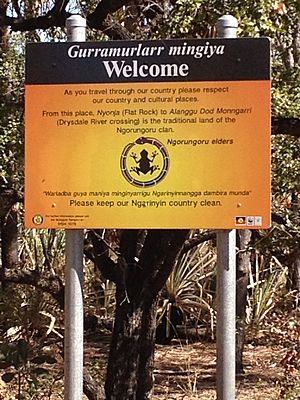Ngarinyin facts for kids
The Ngarinyin people are an Aboriginal Australian group from the Kimberley area in Western Australia. They speak the Ngarinyin language, which is also known as Ungarinyin. When they talk about their traditional lands, they call themselves the Wilinggin people.
Contents
Ngarinyin Language
The Ngarinyin language, sometimes called Ungarinyin, is one of three languages in the Worrorran language family. In 2003, about 82 people spoke Ngarinyin. They lived in an area stretching from Derby to the King River. By 2016, the Australian census showed that 38 people spoke Ngarinyin at home.
Experts say that "Ngarinyin" can refer to both the language and the people who speak it. However, "Ungarinyin" usually refers only to the language. The community has chosen "Ngarinyin" as the main name for their language.
Ngarinyin Social Groups
The Ngarinyin people were made up of about 40 different groups. Each of these local groups had its own special clan and family classifications.
The Wunambal, Worrorra, and Ngarinyin peoples share a special culture. This shared culture is based on their Dreamtime stories and laws. These stories tell about the Wanjina and Wunggurr spirits, who are the ancestors of these peoples. The Wunambal Gaambera Aboriginal Corporation helps represent the Wunambal Gaambera people. They call their traditional land "Uunguu."
Traditional Lands of the Ngarinyin
The Ngarinyin people's traditional lands covered a large area of about 27,195 square kilometres (10,500 square miles). This land stretched from Walcott Inlet at Mount Page. To the southeast, their land followed the northern side of the Wunaamin Miliwundi Ranges.
Their territory included the Isdell Valley and Isdell Range. It went east to the Phillips Range, the start of the Chapman River, Blackfellow Creek, and the Wood River. To the north, their land was along the Barnett and Harris Ranges. It reached where the Gibb River meets the upper Drysdale River, and went across to the Maitland Range. They also lived near the start of the King River, around Mount Reid. Their western border was at Mounts Bradshaw and Han. To the southeast, their land reached Mount French in the highlands.
Before European settlers arrived, it seems the Ngarinyin people were moving south into land that belonged to the Punaba people.
Native Title Rights
In Australia, native title means that Aboriginal and Torres Strait Islander peoples have rights to their traditional lands and waters. The Ngarinyin people, along with the Worrora and Wunambal Gaambera peoples, made a native title claim in 1998. This claim was called the Dambimangari claim.
The Wilinggin claim, which is part of the Dambimangari claim, was the first to be officially decided. This happened on August 27, 2004. This claim covers an area of more than 60,150 square kilometres (23,220 square miles) along the Gibb River Road.
Another claim for 6,903 square kilometres (2,665 square miles) in the Shire of Wyndham-East Kimberley was made in 2002, but it was not accepted. The Kimberley Land Council Aboriginal Corporation helped the people with this claim.
The Wanjina Wunggurr RNTBC is a group that works for the Ngarinyin/Wilinggin, Worrora/Dambimangari, and Wunambal Gaambera/Uunguu native title holders. They help manage their rights and interests in their traditional lands.
Wilinggin National Park
In January 2017, a new park called the Wilinggin National Park was announced. This park includes parts of the existing Mitchell River National Park and Prince Regent National Park. It connects several conservation areas over 200 kilometres (120 miles).
The new park is managed together by the Western Australian government and the Wilinggin traditional owners. This area is next to the northern part of the former King Leopold Ranges Conservation Park, which is now called Wunaamin Conservation Park. There was a plan for the new park to become part of the Kimberley National Park, which would have been Australia's biggest national park. However, this idea was put on hold after a change in government in 2017.
Other Names for Ngarinyin
The Ngarinyin people and their language have been known by several other names, including:
- Andedja
- Andidja
- Angarinjin
- Arawari (meaning "southeastwards" in Worrorran)
- Arkarinjindja
- Gular (a name for some groups, with kular meaning "west")
- Ingarinjindja (a Ngarinyin adult male)
- Marangana (of people who speak like the Ngarinyin)
- Narrinyind
- Ngaring-ngyan
- Ngarinjin
- Ngerringun Kandjalngari (northern group)
- Njingarinjanja (a Ngarinyin adult female)
- Oladjau (Miriwung term for their language)
- Ungarinjin, Unrjarinjin, Ungarinyin, Ungarinjen
- Walmidi (Forrest River name)
- Wangarinjinu
- Warnarinjin


